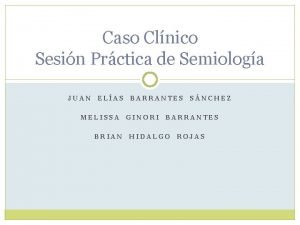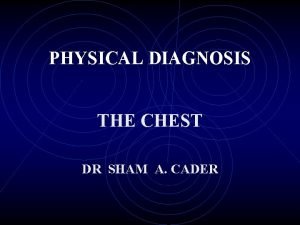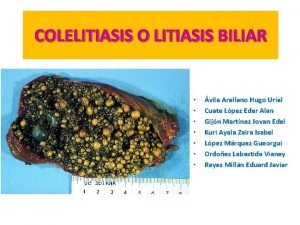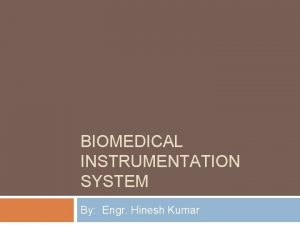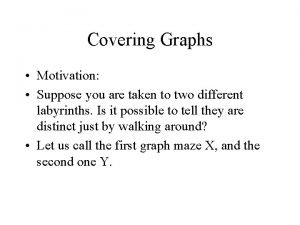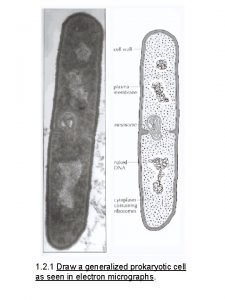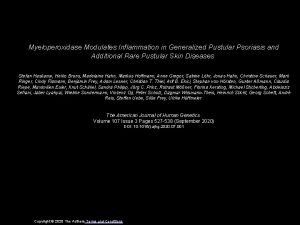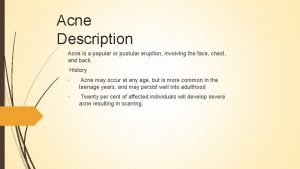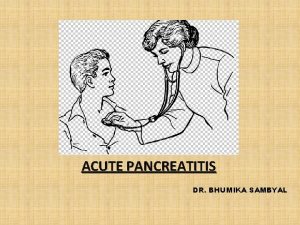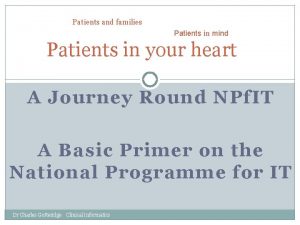Evaluating Patients With Acute Generalized Vesicular or Pustular



























































- Slides: 59

Evaluating Patients With Acute Generalized Vesicular or Pustular Rash Illnesses

Need for a Diagnostic Algorithm? • No naturally acquired smallpox cases since 1977 • Concern about use of smallpox virus as a bioterrorist agent • Heightened concerns about generalized vesicular or pustular rash illnesses • Clinicians lack experience with smallpox diagnosis • Public health control strategy requires early recognition of smallpox case

Need for a Diagnostic Algorithm? • ~1. 0 million cases varicella (U. S. ) this year (2003) and millions of cases of other rash illnesses: – If 1/1000 varicella cases is misdiagnosed 1000 false alarms • Need strategy with high specificity to detect the first case of smallpox • Need strategy to minimize laboratory testing for smallpox (risk of false positives)

Assumptions/Limitations • Will miss the first case of smallpox until day 4 -5 (by excluding maculo-papular rashes) • Will miss an atypical case of smallpox (hemorrhagic, flat/velvety, or highly modified) if it is the first case

Justification • System cannot handle thousands of false alarms • Several days of delay in diagnosis will not have major impact: – Supportive treatment for smallpox – Appropriate contact/respiratory precautions will limit spread in hospital

Smallpox Disease • Incubation Period: 7 -17 days • Pre-eruptive Stage (Prodrome): fever and systemic complaints 1 -4 days before rash onset

Smallpox Disease • Rash stage – Macules – Papules – Vesicles – Pustules – Crusts (scabs) • Scars

Smallpox Surveillance Clinical Case Definition An illness with acute onset of fever > 101 o F (38. 3 o C) followed by a rash characterized by firm, deep-seated vesicles or pustules in the same stage of development without other apparent cause.

Clinical Determination of Smallpox Risk: Major Criteria • Prodrome (1 -4 days before rash onset): – Fever >101 o. F (38. 3 o. C) and, – >1 symptom: prostration, headache, backache, chills, vomiting, abdominal pain. • Classic smallpox lesions: – Firm, round, deep-seated pustules. • All lesions in same stage of development (on one part of the body).

Clinical Determination of Smallpox Risk: Minor Criteria • • • Centrifugal (distal) distribution First lesions: oral mucosa, face, or forearms Patient toxic or moribund Slow evolution (each stage 1 -2 days) Lesions on palms and soles

Smallpox: Day 2 of Rash

Smallpox: Day 4 of Rash

Smallpox Rash Vesicles Pustules Day 4 and 5 Days 7 -11

Classic Smallpox Lesions: Pustules

Rash Distribution

Varicella is the most likely illness to be confused with smallpox.

Differentiating Features: Varicella • No or mild prodrome. • No history of varicella or varicella vaccination. • Superficial lesions “dew drop on a rose petal. ” • Lesions appear in crops.

Differentiating Features: Varicella • Lesions in DIFFERENT stages of development. • Rapid evolution of lesions. • Centripetal (central) distribution. • Lesions rarely on palms or soles. • Patient rarely toxic or moribund.

Varicella

Varicella Adult Case

Varicella: Infected Lesions

Varicella Variola

Differentiation of Rash Illness Smallpox

Chickenpox Smallpox

Distribution of Rash Chickenpox

Distribution of Rash Smallpox

Distribution of Rash Smallpox

Differential Diagnosis Condition Clinical Clues • Most common in children <10 years • Children usually do not have a viral prodrome Disseminated herpes zoster • Prior history of chickenpox • Immunocompromised hosts Impetigo (Streptococcus • Honey-colored crusted plaques with bullae pyogenes, Staphylococcus • May begin as vesicles aureus) • Regional not disseminated Drug eruptions and contact • Exposure to medications dermatitis • Contact with possible allergens Erythema multiforme (incl. • Major form involves mucous membranes Stevens Johnson Sd) and conjunctivae Varicella (primary infection with varicella-zoster virus)

Differential Diagnosis Condition Clinical Clues Enteroviruses incl. Hand, Foot and Mouth disease • Summer and fall • Fever and mild pharyngitis at same time • Small vesicles on hands, feet and mouth or disseminated • Lesions indistinguishable from varicella • Immunocompromised host • Pruritis • In scabies, look for burrows • Vesicles and nodules also occur • Flea bites are pruritic • Patient usually unaware of flea exposure Disseminated herpes simplex Scabies; insect bites (incl. fleas)

Differential Diagnosis Condition Clinical Clues Molluscum contagiosum • Healthy afebrile children • HIV+ individuals Bullous Pemphigoid • Bullous lesions • Positive Nikolski sign Secondary syphilis • Rash can mimic many diseases • Rash may involve palms and soles • 95% maculo-papular, may be pustular • Sexually active persons Vaccinia • Recent vaccination or contact with a vaccinee

Differential Diagnosis Herpes Zoster

Differential Diagnosis Drug Eruptions • History of medications: – Prescription – Over the Counter – Prior Reactions

Differential Diagnosis Drug Reaction

Differential Diagnosis Hand Foot and Mouth Disease

Differential Diagnosis Molluscum Contagiosum

Differential Diagnosis Secondary Syphilis

Differential Diagnosis HSV 2 Disseminated HSV 2 lesions on face/scalp Disseminated HSV 2 lesions on palms

Clinical Determination of the Risk of Smallpox Variations on Smallpox Hemorrhagic smallpox: Misdiagnosed as meningococcemia? Flat-type smallpox: Difficult diagnosis

Goal: Rash Illness Algorithm • Systematic approach to evaluation of cases of febrile vesicular or pustular rash illness. • Classify cases of vesicular/pustular rash illness into risk categories (likelihood of being smallpox) according to major and minor criteria developed for smallpox according to the clinical features of the disease.

Investigation Tools • Available at www. cdc. gov/smallpox: – Rash algorithm poster: • Health care providers link to view and print poster. – Worksheet (case investigation)


Investigation Tools • Case investigation worksheet for investigation of febrile vesicular or pustular rash illnesses: – Questions on prodromal symptoms, clinical progression of illness, history of varicella, vaccinations for smallpox and varicella, exposures, lab testing. – Worksheet can be downloaded and printed from www. cdc. gov/smallpox.


Smallpox: Major Criteria • Prodrome (1 -4 days before rash onset): – Fever >101 o. F (38. 3 o. C) and, – >1 symptom: prostration, headache, backache, chills, vomiting, abdominal pain. • Classic smallpox lesions: – Firm, round, deep-seated pustules. • All lesions in same stage of development (on one part of the body).

Smallpox: Minor Criteria • • • Centrifugal (distal) distribution. First lesions: oral mucosa, face, or forearms. Patient toxic or moribund. Slow evolution (each stage 1 -2 days). Lesions on palms and soles.

Rash Evaluation Flow

Immediate Action for Patient with Generalized Vesicular or Pustular Rash Illness • Airborne and contact precautions instituted • Infection control team alerted • Assess illness for smallpox risk

Safety Precautions • Respiratory and contact precautions • Isolation Rooms • Gloves • Hand Washing

Clinical Determination of the Risk of Smallpox High Risk of Smallpox report immediately • Prodrome AND, • Classic smallpox lesions AND, • Lesions in same stage of development.

Response: High Risk Case • Infectious diseases (and possibly dermatology) consult to confirm high risk status • Obtain digital photos • Alert public health officials that high risk status confirmed: – specimen collection – management advice – laboratory testing at facility with appropriate testing capabilities

Clinical Determination of the Risk of Smallpox Moderate Risk of Smallpox urgent evaluation • Febrile prodrome AND • One other MAJOR smallpox criterion OR • >4 MINOR smallpox criteria

Response: Moderate Risk Case • Infectious diseases (and possibly dermatology) consult • Laboratory testing for varicella and other diseases • Skin biopsy • Digital photos • Re-evaluate risk level at least daily

Clinical Determination of the Risk of Smallpox Low Risk of Smallpox manage as clinically indicated • No/mild febrile prodrome OR • Febrile prodrome AND • < 4 MINOR smallpox criteria (no major criteria)

Response: Low Risk Case • Patient management and laboratory testing as clinically indicated

Smallpox Pre-event Surveillance • Goal to recognize the first case of smallpox early without: – Generating high number of false alarms through conducting lab testing for smallpox cases that do not fit the case definition – Disrupting the health care and public health systems – Increasing public anxiety

Smallpox Differential Diagnosis: Lessons from the Past CONDITION Variola Major Variola Minor Eng. /Wales, 1946 -48 Somalia, 1977 -79 Chickenpox 41 20 Acne 10 0 Erythema Multiforme 7 Allergic Dermatitis/Urticaria 7 1 Syphilis 3 4 Drug Rash 6 1 Vaccinia 5 1 Other diagnoses 18 3 TOTAL 97 29

CDC Rash Illness Response Team Experience with Use of Algorithm • 25 calls to CDC January 1 – December, 2002 • Smallpox risk classification: – – – High risk = 0 Moderate risk = 4 Low risk = 21

CDC Rash Response Team Experience with Use of Algorithm • >50% of the cases including 2 deaths have been varicella • 14 diagnoses confirmed by lab and/or pathology; 11 clinically diagnosed • Other diagnoses: – – – drug reaction erythema multiforme, Stevens Johnson disseminated herpes zoster disseminated HSV 2 contact dermatitis other dermatological disorders

Experience with Implementation of Rash Algorithm • Rule in VZV!! • Algorithm has limited variola testing by standard approach to evaluation
 Vibraciones vocales abolidas
Vibraciones vocales abolidas Amplexacion
Amplexacion Traube space
Traube space De que esta hecho el aparato de golgi
De que esta hecho el aparato de golgi Litiasis vesicular radiografia
Litiasis vesicular radiografia Igneous rock
Igneous rock Egophony
Egophony What does vesicular texture mean
What does vesicular texture mean Vesicular texture definition
Vesicular texture definition Igneous rocks texture
Igneous rocks texture Vibraciones vocales abolidas
Vibraciones vocales abolidas Ducts in female reproductive system
Ducts in female reproductive system Cerebellar sulci
Cerebellar sulci Generalized medical instrumentation system
Generalized medical instrumentation system Aturan fuzzy
Aturan fuzzy Examples of generalized anxiety disorder
Examples of generalized anxiety disorder Generalized biogeochemical cycle
Generalized biogeochemical cycle Transition graph in automata
Transition graph in automata Hierarchy theory of motor control
Hierarchy theory of motor control Permutations
Permutations Varea
Varea Generalized transition graph
Generalized transition graph Generalized anxiety disorder dsm 5
Generalized anxiety disorder dsm 5 Circular reasoning aba
Circular reasoning aba Generalized pca
Generalized pca Supporting cells
Supporting cells What is transition graph
What is transition graph Generalized forwarding and sdn
Generalized forwarding and sdn Classification of biomedical instruments
Classification of biomedical instruments Generalized forwarding and sdn
Generalized forwarding and sdn Examples of generalized anxiety disorder
Examples of generalized anxiety disorder Low biodiversity
Low biodiversity Generalization examples
Generalization examples Polymorphic opinion leader
Polymorphic opinion leader Generalized forwarding and sdn
Generalized forwarding and sdn Lagrange equation
Lagrange equation Generalized wiener process
Generalized wiener process The views of ____ comprise the generalized other
The views of ____ comprise the generalized other Generalized petersen graph
Generalized petersen graph Generalized processor sharing
Generalized processor sharing Generalized model public health
Generalized model public health Spatial interaction ap human geography
Spatial interaction ap human geography Sas generalized linear model
Sas generalized linear model Implicature and explicature in pragmatics
Implicature and explicature in pragmatics Addition of two polynomials using linked list in c
Addition of two polynomials using linked list in c One period valuation model
One period valuation model Agoraphobia vs social phobia
Agoraphobia vs social phobia Avl tree haskell
Avl tree haskell Generalized principal component analysis
Generalized principal component analysis Generalized transition graph
Generalized transition graph Prokaryotic cell drawing
Prokaryotic cell drawing Audit approach
Audit approach Types of edema
Types of edema Smooth endoplasmic
Smooth endoplasmic Generalized permutations and combinations
Generalized permutations and combinations Generalized pruritus
Generalized pruritus Particularized conversational implicature
Particularized conversational implicature Linear phase system
Linear phase system Generalized global symmetries
Generalized global symmetries Relational algebra
Relational algebra

